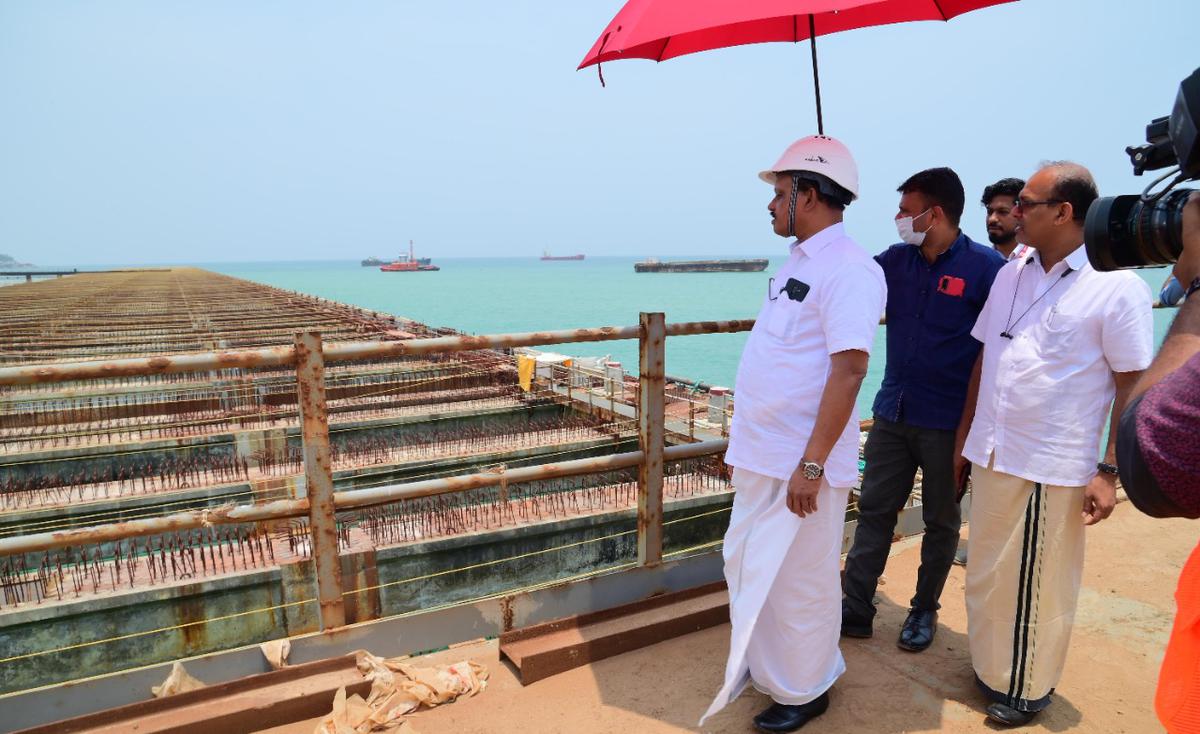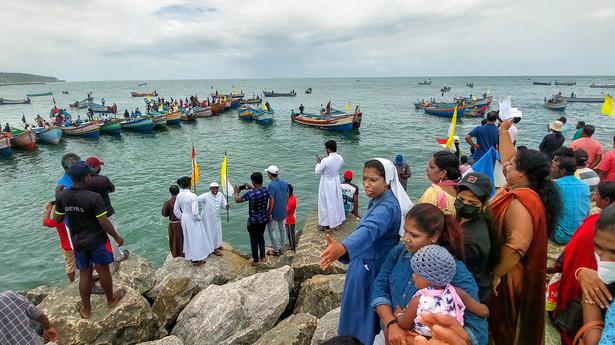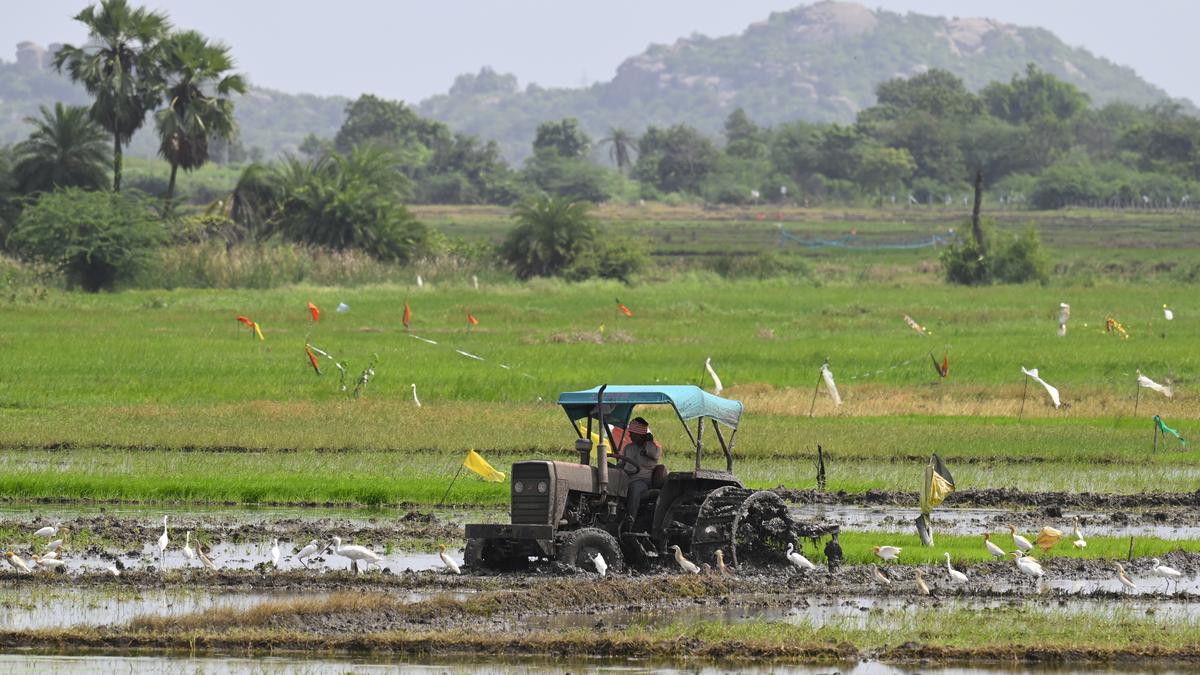Why have the fisherfolk living in and around Vizhinjam laid siege to the international port project? Is the port construction causing increased sea erosion in the area?
Why have the fisherfolk living in and around Vizhinjam laid siege to the international port project? Is the port construction causing increased sea erosion in the area?
The story so far: Vizhinjam, a small coastal village that lies around 20 km south of Thiruvananthapuram, is on the boil for the past two weeks with fisherfolk and their families laying siege to the under-construction Vizhinjam International Seaport, from both sea and land. The protestors led by the Latin Archdiocese, Thiruvananthapuram, have been holding day-and-night sit-ins in front of the port since August 16, disrupting the construction work by the Adani Vizhinjam Port Private Limited, which is developing the port on Design, Build, Finance, Operate, Transfer (DBFOT) basis.
Though the Kerala Government reached out to protestors, the fisherfolk led by the Catholic Church, refused to halt the protest saying any compromise without stopping the work on the ₹7,500-crore all-weather port is not acceptable.
What lies at the heart of the protest?
Fisherfolk sieged the port using their vessels as well
| Photo Credit: SPL
According to fisherfolk, the port work has aggravated the coastal erosion along the coast of Thiruvananthapuram. A scientific study to assess the impact of the port work on the shoreline has to be conducted urgently by stopping the construction. Further, around 300 families along the coastline were shifted to relief camps after their houses were destroyed due to high-intensity coastal erosion. The protesters demand a comprehensive rehabilitation package, an assured minimum wage when the sea turns rough due to inclement weather and subsidised kerosene for boats.
Also read: Vizhinjam port | In troubled waters
Has the port work aggravated the coastal erosion?

A women arranges gunny sacs filled with sand to protect her house from sea erosion at Vettukad, in Thiruvananthapuram
| Photo Credit: MAHINSHA S
In fact, all type of construction works along a coast aggravate sea erosion (loss of beach) and accretion (gain of beach). The longshore drift along the coast of Kerala with waves approaching the beach at a certain angle (mostly from south to northwards) has been transporting the sand along with waves, resulting in erosion and accretion based on the topography of each terrain. Any structure — be it groyne, seawall, or breakwater — intensifies erosion on one side and accretion on the other. Although coastal erosion is dominant in all coastal districts of Kerala, it is more severe along the coastline of Thiruvananthapuram.
A study ‘shoreline assessment for Kerala coast’ conducted by the National Centre for Sustainable Coastal Management (NCSCM), Society of Integrated Coastal Management, and the Ministry of Environment and Forest by assessing the shoreline changes for a period of 38 years from 1972 to 2010 in Kerala, had noted that the erosion is minimum at Thrissur (1.5 %) and maximum at Thiruvananthapuram (23%), even before the port construction. In the case of Kerala, the seasonal shoreline changes would be more severe during monsoon months due to the high-energy short storm waves that lash the coast almost in a perpendicular position moving the sand offshore.
The latest report of the expert committee appointed by the National Green Tribunal (NGT) and Shoreline Monitoring Cell formed to monitor the shoreline changes in the project area — within 10 km on either side of the port — observed that erosion in spots such as Valiyathura, Shanghumugham, and Punthura remains the same before and after the commencement of the port construction (December 2015). However, during the October 2020–September 2021 period, spots like Kochuveli and Cheriyathura to the north of Valiyathura suffered erosion, and accretion was noted in some other spots.
Maximum wave height (Hmax) recorded along Vizhinjam coast post-Ockhi
Average wave height during: normal rough weather period – 2.5 m; normal fair-weather condition – 1 m
Cyclone Ockhi – 7.29 m
Depression over Arabian Sea – 6.2 m
Cyclone Luban – 3.62 m
Cyclone Vayu – 6.13 m
Cyclone Maha – 6.13 m
Cyclone Amphan – 4.99 m
Cyclone Nisarga – 4.5 m
Low pressure under the influence of cyclonic circulation – 8.84 m
Deep depression over East Central Bay of Bengal- 4.5 m
Cyclone Gati – 2.92 m
Cyclone Tauktae – 9.44 m
Source: National Centre for Sustainable Coastal Management, Ministry of Environment and Forests, Government of India
The report noted that the relatively high number of cyclones formed over the Arabian sea after cyclone Ockhi in 2017 was the main reason for the recent erosion and accretion and that the impact of the port activity on either side of the coast had less significance till date. However, it suggested continuous monitoring of the port activity and its impact on the coast.
The report by the National Institute of Ocean Technology (NIOT) which assessed the shoreline changes for the committee, provides details of the maximum wave height reported during this period. During the time of Ockhi, the maximum wave height along the coast reached 7.29 m, which rose to 9.44 m during the time of cyclone Tauktae in 2020, compared to around 2.5 m in normal rough sea conditions and 1 m in normal fair-weather times.
Also read: Climate vagaries to blame for coastal erosion: studies
What do the fisherfolk say?
The protesters argue that though the coastline of Thiruvananthapuram was already seeing high erosion, it was only after the construction of a breakwater (only 33 percent of the 3.1 km breakwater has been completed to date) as part of the port, that the high-intensity erosion started damaging their houses and livelihood means. They are demanding a study led by experts, including representatives from their community, which, according to them, can only unearth the impact of the port work on the shoreline.
Also read: Expert committee to study fishers concerns about Vizhinjam port
What is the stance of Vizhinjam International Seaport Ltd (VISL) and the Kerala Government?

Minister for Ports Ahmed Devarkovil reviewing the constriction of Vizhinjam port
Officials argue that Vizhinjam seaport is being constructed inside a natural sediment cell which is a pocket-like area in which interruptions to the movement of sand along the coast do not significantly affect the adjacent coastline. Further, around 5 km north of the port, there are rocky headlands and pocket beaches where sediment transport due to longshore drift is relatively low compared to other parts.
In fact, any port structure could affect its adjacent shores only by way of blocking the longshore drift happening along its coast, which was not taking place in this case. Had the port been developed on a linear coast, adjacent shores would have seen very visible impact. They further argue that the breakwater structure will not divert the wave energy to other locations leading to erosion. The wave fields after hitting the breakwater, cannot prolong. It dies down immediately, according to VISL.
However, the port development is likely to cause minor accretion for about 2.6 km to the south of the port, the maximum rate being 21.6 m per year reducing to 0.6 m per year by the tenth year and stablising thereafter, according to a study conducted by L&T-Ramboll Consulting Engineers Limited, a NABET accredited consultant as part of the Environmental Impact Assessment (EIA).
The Kerala Government made it clear that since the coastal erosion is due to climate change as reported by various agencies, the demand for stopping the port construction cannot be conceded. However, the Government has expressed willingness to address all other issues raised by the fisherfolk including their rehabilitation and livelihood concerns. Chief Minister Pinarayi told the Assembly on Tuesday that an expert committee would be constituted to study the impact of the port work. Earlier, the High Court had made it clear that the work on the seaport project cannot be halted.
Why is the Vizhinjam project considered important?
Located on the southern tip of the Indian Peninsula, just 10 nautical miles from the major international sea route and east-west shipping axis, and with a natural water depth of more than 20 m within a nautical mile from the coast, the Vizhinjam port is likely to play a pivotal role in the maritime development of the country and Kerala. The commissioning of the port is expected to leverage the growth of 17 minor ports in the State along with creating thousands of employment opportunities.
Also read: The visionary who foresaw the potential of Vizhinjam to turn 100






